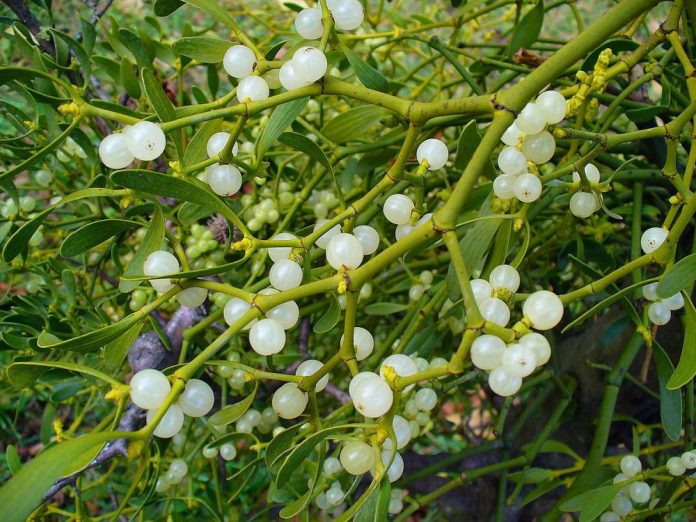Mistletoe has been used by many ancient cultures, and although the leaves and berries of some species are toxic the plant has also been used historically for curing a number of ailments, including arthritis and infertility. It was also associated with peace and love by the Romans, who hung it over doorways to protect the household.
It has become a part of Christmas celebrations worldwide since the 18th century, and nowadays couples are expected to kiss when standing under a bunch of mistletoe. This tradition has been popularized by the music of the 50’s – “I saw Mommy kissing Santa Claus, underneath the mistletoe last night….”, and by more recent songs. The tradition of kissing under the mistletoe became very popular with the servants in Victorian times. Apparently any man could kiss a woman who was standing under the mistletoe, and if she refused him she would suffer from bad luck. At one time a berry was removed for every kiss, until the branch was bare – and presumably the kissing stopped. This tradition is no longer popular, probably because bunches of mistletoe are usually quite small and expensive in countries where the European mistletoe does not grow, and often artificial plants are used, making the berries non-expendable.
Mistletoes are hemiparasitic plants that feed on other plants, so they do not need roots to grow in the soil, or green leaves that can photosynthesize. They produce specialized structures called haustoria that penetrate the host plants’ tissues to extract the water and nutrients necessary for their growth. However, they do have leaves capable of photosynthesis for part of their life cycle. A commonly known species of mistletoe, the European mistletoe (Viscum album), is native to Britain and much of Europe, and it is the mistletoe plant used in Christmas decorations. It is very noticeable in British apple orchards, particularly in wintertime, when the trees are leafless. The mistletoe consists of woody stems that bear smooth-edged, oval, yellowish evergreen leaves and waxy, white berries that are present on the branches in clusters of 2-6. Mistletoe berries contain seeds that are coated with a sticky jelly called viscin, and for many species the seeds are spread by birds. Different kinds of birds spread the berries of different species, and they may use different methods. The seeds may be ingested, then regurgitated from the crop. Seeds of other mistletoe species may pass through the digestive tract and are then dispersed in the bird droppings. The seeds may also stick to the bill of a feeding bird, and are then wiped off onto the bark of a different tree. When the seed germinates on the branch of a suitable host, it produces a hypocotyl (the stem of a germinating seedling) that grows towards the bark of the tree, and eventually penetrates the bark. This can take a year or more, and until the haustorium is formed inside the host and reaches the conductive tissue, the mistletoe has to rely on its own photosynthesis to survive and grow.
Other species of parasitic plants that grow in a similar fashion are also called mistletoe, and they are found in many parts of the world, including South America and Australia. There is even a species of mistletoe that occurs in Saskatchewan. Dwarf mistletoe (Arceuthobium pusillum) is parasitic on white spruce and other conifers. It has a fragile stem, and small, scale-like leaves. There are male and female flowers, found on separate plants, and although the mistletoe plant itself is inconspicuous it causes the host tree to form many branches around the infected area. These bushy growths are called “witches’ broom” and are very noticeable. I recall collecting specimens from infected coniferous trees south of Meadow Lake for plant pathology classes in the 1980’s, and they were easy to spot. Dwarf mistletoe is not a species that could be used as a Christmas decoration! It is now rare in the province and is only found in eastern Saskatchewan.
Very best wishes for a happy holiday season, I hope you have many festive plants to enjoy.
Jill Thomson is a plant disease specialist (retired) who enjoys gardening in Saskatoon with her family, including the dogs. This column is provided courtesy of the Saskatchewan Perennial Society (SPS; saskperennial@hotmail.com ). Check our website (www.saskperennial.ca) or Facebook page (www.facebook.com/saskperennial) for a list of upcoming gardening events
18.9 C
Prince Albert
Friday, July 26, 2024


